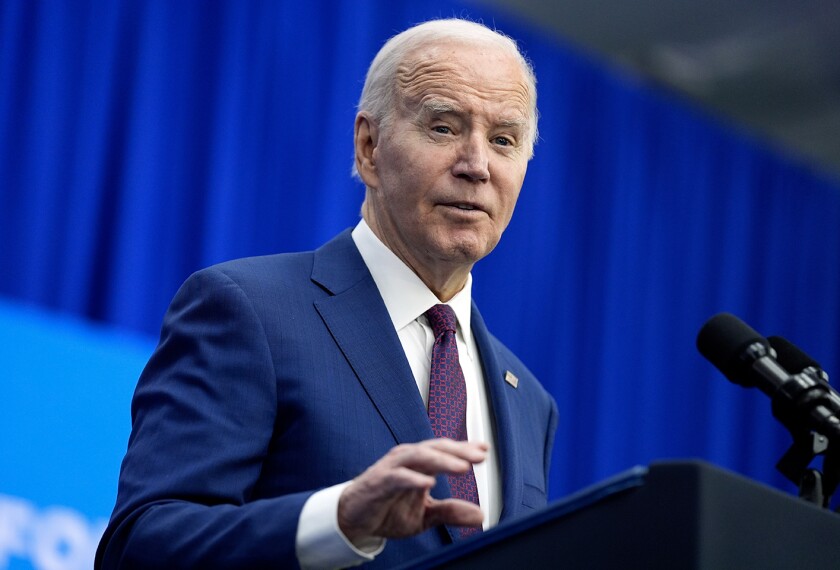President Reagan did it. So did the first President Bush. President Clinton did it, too. Repeatedly.
So it should have come as no surprise when the current President Bush unveiled his recommended federal spending plan for fiscal 2004 early this month that he included a sharp cut in aid to school districts adversely affected by the heavy presence of tax-exempt federal facilities and American Indian lands. Likewise no surprise: the anguished cries from the advocates for what is known as impact aid.
If the president, in the end, bows to Congress’ wishes and signs an appropriations bill restoring all that aid, or even adding more, that will be no shocker either.
His immediate predecessors all engaged in a similar dance over the past 20 years with Congress. And in most of those years, the program’s bipartisan appeal—at least 250 congressional districts have one or more school systems getting impact aid, most of them because of military installations—has trumped Republican and Democratic presidents’ bids to save the money or spend it some other way.
“What would happen consistently is the Congress would turn back the proposal,” said John Forkenbrock, who as the executive director of the National Association of Federally Impacted Schools has been manning the impact-aid barricades in Washington since 1988. “So [presidents] were able to get their cake and eat it too. ... It’s always been a gimmick, in my opinion.”
If that’s true, the sitting president resisted gimmickry for his first couple of trips around the budget track. President Bush, in fact, was the first chief executive to break the billion-dollar barrier for impact aid when he asked for $1.13 billion for fiscal 2002. (Congress, not to be outdone, appropriated more: $1.14 billion.) Last year, in his request for fiscal 2003, Mr. Bush sought to keep impact aid level; Congress added $74 million.
But he did an about-face earlier this month, requesting that for fiscal 2004, which begins Oct. 1, Congress change the eligibility rules and allot impact aid based only on students who actually live on military bases or Indian land. The children of military personnel who live off base, under his proposal, would not trigger impact aid for their school districts.
President Reagan made a similar suggestion, as did Mr. Bush’s father and President Clinton. The current President Bush also suggested that the aid for fiscal 2004 be trimmed to just over $1 billion, about a $173 million cut.
The reaction was instant, and vehement. Administrators asked how a president seemingly on the verge of sending soldiers into battle could simultaneously recommend lowering aid to their children’s districts.
“I think it’s really critical that our military troops don’t sense that their families aren’t of value,” said Ronald Singletary, the superintendent of the 21,700-student Onslow County Public Schools in Jacksonville, N.C. The district includes Camp Lejeune and its 43,000 members of the U.S. Marines Corps and U.S. Navy.
Already, about 18,000 men and women from Camp Lejeune have been deployed as part of U.S. operations in Afghanistan and the Persian Gulf. Under the president’s proposal, despite having about 7,300 students with parents connected to the base, the Onslow district would lose the nearly $1.8 million it received in impact aid this year.
Actually, another president named Bush made the identical suggestion in February 1991, even as bombs showered Baghdad and American troops cleaned their rifles at the Kuwaiti border.
Congress didn’t bite then. And the Republican congressman who represents the North Carolina district that includes the Onslow schools, Camp Lejeune, and two other military bases says the federal lawmakers won’t this time around either.
“Knowing how the Congress has supported impact aid in the past, I don’t give it much chance at all,” Rep. Walter B. Jones said of the latest Bush proposal. “Not at all.”
Tip’s Tip
The problem is property taxes. And sales taxes. And, in some states, income taxes.
Federal installations and, by and large, members of the military don’t have to pay them to local governments, including school districts. Congress recognized that politically sticky situation when it enacted the impact-aid program in 1950.
But beyond that relatively tangible concept, it gets complicated.
How should Uncle Sam compensate a district if the student and his soldier-parent (or parents) live, say, in an apartment complex a quarter- mile from the base? That family wouldn’t pay property taxes, true, but the apartment owner would. That family would probably do much of its shopping on base, sales tax-free. And many soldiers establish their official residency elsewhere, paying no local or state income taxes where they’re actually stationed.
Seeking to balance such questions, Congress established so- called “a” students (named for a long-ago notation in federal statutes), those who live on base or on Indian land, and “b” students, mostly children of military personnel who live off base. School districts get five times as much aid for “a” students—about $3,500 a year—as they do for the others.
It’s those “b” students that President Bush suggests cutting loose from impact aid, concentrating the money on the districts said to be most heavily affected, and on other needs.
“As important a part of the program as [the ‘b’ student] is,” said Deputy Secretary of Education William D. Hansen, “when we put that up against Title I and reading programs and teaching programs, that was where our priorities needed to be.”
According to Mr. Forkenbrock, taking “b” children out of the equation would zero out about 550 of the 1,300 districts currently receiving payments. That would continue a steady ebbing of districts that get the aid, a trend that began in the first years of the Reagan administration.
In 1981, about 4,000 districts received nearly $760 million in impact aid. Mr. Reagan, elected on a promise to cut spending and taxes, recommended slicing the program to about $400 million. Congress came close, settling on $475 million.
President Reagan stayed the course for a while, recommending $292 million the next year. But by the end of his eight years, his recommendations and what Congress allocated for impact aid had risen back to around $700 million.
The first President Bush consistently recommended trims, too, including a quixotic $211 million cut in early 1992. Congress kept the funding basically unchanged.
President Clinton recommended impact-aid cuts year after year, even as he pushed for greater education spending overall. Congress, with the exception of the first years after Republicans took over the House in 1995, tended to do the opposite: undershoot Mr. Clinton’s overall education number, while overshooting (by steadily increasing amounts) his impact-aid recommendations.
The last Clinton-era budget, fiscal 2001, put $993.3 million into impact aid.
Ted Sanders, the president of the Education Commission of the States, was acting secretary of education when the first President Bush took his unsuccessful 1991 fling at ending the eligibility of the students who live off base. Mr. Sanders has a ready explanation for what happened then, and since, with impact aid.
“It’s [former Speaker of the House] Tip O’Neill’s ‘all politics are local,’ ” he said. And nothing makes more noise locally than the prospect of millions of federal dollars disappearing.
“You’ve got to represent your constituents,” Mr. Sanders said.




